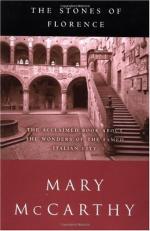
|
| Name: _________________________ | Period: ___________________ |
This test consists of 15 multiple choice questions and 5 short answer questions.
Multiple Choice Questions
1. What is the object that is most frequently stolen in Florence?
(a) Camera.
(b) Wallet.
(c) Bicycle.
(d) Passport.
2. According to Chapter 2, by the time Michelangelo was an old man, who could afford to commission a work from him?
(a) Universities.
(b) Merchants.
(c) Groups of townspeople.
(d) Popes.
3. What is the color scheme of the Baptistery?
(a) Blue and gold.
(b) Black and white.
(c) Pink and brown.
(d) Grey and brown.
4. What was the name of Florence's prospective satellite city?
(a) Sorgane.
(b) Sarbane.
(c) Zigurrat.
(d) Piazza della Romana.
5. Who is the person mentioned in Chapter 3 who did not exact revenge from someone he came across on Good Friday?
(a) Saint Giovanni Gualberto.
(b) Uberti.
(c) Cosimo il Vecchio.
(d) Michelangelo.
6. Whom did Dante see at the Badia?
(a) Augustine.
(b) Ambrose.
(c) Catherine of Siena.
(d) Beatrice.
7. According to Chapter 1, who normally sells the postcards in a Florentine church?
(a) The sacristan.
(b) A nun.
(c) The priest.
(d) No one.
8. Where is Donatello's David?
(a) The Bargello.
(b) The Palazzo Strozzi.
(c) The Uffizi.
(d) The Baptistery.
9. What is Donatello's statue of John the Baptist as a boy called?
(a) San Giovannino.
(b) The Voice in the Wilderness.
(c) San Giovanni ante Baptiste.
(d) Little John.
10. According to the medieval conception of Florence, which city is Florence's mother?
(a) Alexandria.
(b) Constantinople.
(c) Rome.
(d) Athens.
11. According to the author's opinion as stated in Chapter 1, Italians are not what?
(a) "Civic-minded."
(b) "Fastidiously religious."
(c) "Accustomed to fast food."
(d) "Willing to sit in traffic."
12. As mentioned at the end of Chapter 1, who hid in the German Institute during World War II?
(a) Fascists.
(b) Anti-Nazis.
(c) Nazis.
(d) Communists.
13. What is the bird of Florence?
(a) A crow.
(b) A swallow.
(c) A bluebird.
(d) A sparrow.
14. Who was the first Florentine Christian martyr?
(a) San Fernando.
(b) San Juan de la Cruz.
(c) Saint Stephen.
(d) San Miniato.
15. Where did Buondelmonte de' Buondelmonti, the bridegroom mentioned in Chapter 2, die?
(a) The Piazza della Republica.
(b) The Uffizi.
(c) The Boboli.
(d) The Ponte Vecchio.
Short Answer Questions
1. Who broke the Florentine custom of honoring the public far above the individual?
2. What day is market day in Florence?
3. To what city is Florence compared in the beginning of Chapter 1?
4. According to the medieval belief, who were the ancestors of the Blacks in Florence?
5. Which poets touted a "tooled-leather idea of Florence as a dear bit of the old world"?
|
This section contains 390 words (approx. 2 pages at 300 words per page) |

|




